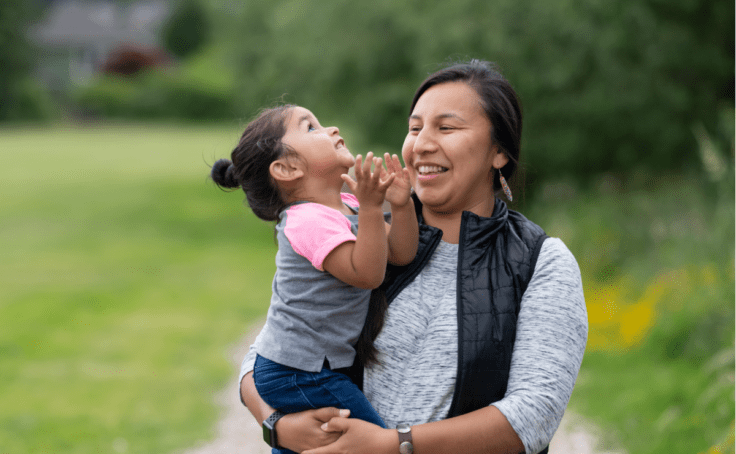How can the Safe Babies approach work in tribal communities?


Collaboration is the key to transforming early childhood systems and creating brighter futures for families. We know that parents…
In 2009, the Eastern Band of Cherokee Indians in the state of North Carolina successfully implemented the Safe Babies approach for five years. As a technical assistance partner to the tribe, we shared responsibility for supporting an effective Safe Babies approach. We helped increase their capacity to provide Child Parent Psychotherapy with a holistic approach for addressing the entire family. We also supported the formation of a new partnership between the tribal court and the state’s child welfare system that allowed each family to have only one court case. While we’re proud of this work, it was a learning experience and I’m appreciative of the tribe’s feedback that we took into our next partnership.
During 2016-2018, we supported the exploration and initial implementation of Safe Babies with the Muscogee (Creek) Nation in Oklahoma. The program worked to create a community-centered family contact location for the families participating in Safe Babies. They utilized two fully furnished apartments so families could interact with their children in a real home-like space. They also developed a cultural center to ensure children were immersed in their own culture including protecting their Native language. However, after judicial and staff shifts, the tribe decided to pause continued development of the program.
As a result of these experiences, we wanted to build our capacity to work more effectively with potential tribal partners, so we reached out to the National Indian Child Welfare Association (NICWA) and asked them to join as a partner on our project.
Janie Huddleston
As we move forward, we are:
- Recognizing that each tribe is different and identifying language and questions to acknowledge and honor that uniqueness with our approaches.
- Supporting growth and continuous quality improvement by using a relational worldview instead of a linear worldview to capture qualitative gains in the application, recognizing that wisdom is knowledge in context.
- From the onset of establishing a new site, utilizing a relational method to allow tribal leaders and members to contextualize Safe Babies for their community and create durable partnerships within this approach.
- Expanding on concepts that will highlight the baby within the family unit by supporting capacity building of specific infant/toddler-focused interventions that Tribal communities find beneficial.
We are excited to explore potential interests from Tribal communities in implementing or restarting the Safe Babies program. Through the Safe Babies approach, we can strengthen families and support the well-being of Native babies and families to prevent involvement in the child welfare system.

Dr. Sarah Kastelic (Alutiiq), an enrolled citizen of the Native Village of Ouzinkie, became the executive director of the National Indian Child Welfare Association (NICWA) in January 2015. Prior to joining NICWA as chief of staff in 2011, Sarah led the National Congress of American Indians’ (NCAI) welfare reform program and, in 2003, was the founding director of NCAI’s Policy Research Center. She began her career at the Bureau of Indian Affairs central office as a child welfare specialist in 1998.
Prior to colonization, American Indian and Alaska Native practices and beliefs about raising a child allowed a natural system of child protections to flourish. Traditional Native spiritual beliefs reinforce that all things have a spiritual nature that demands respect, including children. Traditionally, not only are children respected, but they are taught to respect others. Extraordinary patience and tolerance mark the methods that have been and are still used today to teach Native children self-discipline.
At the heart of a natural system are beliefs, traditions, and customs involving extended family with clear roles and responsibilities. Responsibilities shared by extended family and community members make the protection of children the responsibility of all people in the community. Within the natural safety net of traditional tribal settings and beliefs, child maltreatment was rarely a problem.
Children were removed to boarding schools; they were parented by institutions, not loving relatives. Children lost their language, spiritual teachings, and traditional ecological knowledge. Federal records indicate that the United States viewed official disruption to the Indian family unit as part of Federal Indian policy to assimilate Indian children.
A growing body of research shows that culture is an important protective factor for Native children and youth.5 Research shows that when kids are connected to their identity and culture it leads to positive outcomes, including higher self-esteem, academic achievement, higher social functioning, increased resilience, and improved physical and psychological health. Studies have reported the positive effects of cultural identity on negative outcomes such as suicide, school dropout, and substance abuse.
Tribal nations play a key role in ensuring the well-being of Native children; they have knowledge and relationships that position them to make decisions in the best interest of their member children. In recent years, an increasing number of tribal nations have decolonized their child welfare systems, refounding them based on their tribal cultures, worldviews, values, and traditional beliefs.
Building on the Indian Child Welfare Act
The Indian Child Welfare Act (ICWA) was enacted in 1978 in response to a crisis affecting American Indian and Alaska Native children, families, and tribes. Research found that 25%–35% of all Native children were being removed; of these, 85% were placed outside of their families and communities—even when fit and willing relatives were available.
The disproportionality rate of native children in state child welfare systems is still about 2.76 compared to non-native children.
The judge is three times more likely to remove the native child than a white child so we know there's still bias in the system that we're dealing with.
Sarah Kastelic
Hear more from Sarah and see how other ZERO TO THREE programs are working to support tribal communities.

